James Hobson Turns Fantasy to Reality
James Hobson Turns Fantasy to Reality
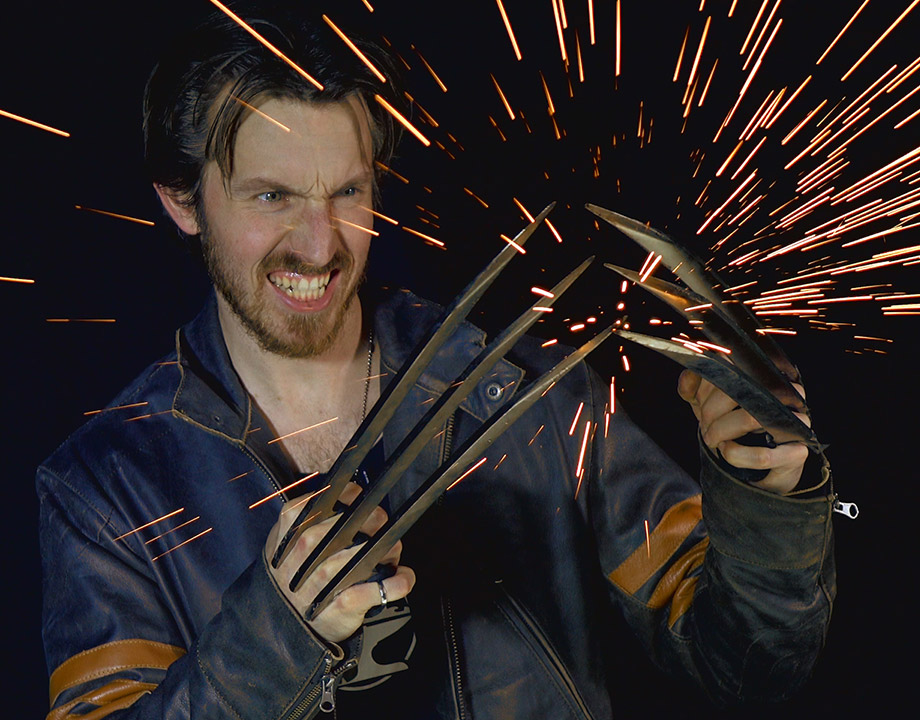

James Hobson got the idea for videos that showed how he turned fiction into reality when he made a set of Wolverine claws for a Halloween party. Photo: Hacksmith Entertainment
When 30-year-old James Hobson delivers his keynote at AMUG (Additive Manufacturers Users Group), a popular industry and enthusiasts gathering that will take place in Chicago March 23-26, he is likely to show a video.
He has more than 150 from which to choose. He might showcase his latest project, a half-size clone of Tesla’s Cyber Truck. Or perhaps he will screen the video that made him famous. It features an electromagnetic bracer that can retrieve a Captain America shield when it is flying through the air.
Or he might show something like the 60-lb. Reinhardt’s Rocket Hammer. Inspired by the video game Overwatch, it packs a solid fuel rocket engine at the back of its head. This gives an extra oomph to its gangling inventor to smash up the windows, sides, hood, and bumpers of a Pontiac Sunfire. On the video, he then demolished what was left of the car with a backhoe. Why? Because, well, why not?
Demolition—breaking things, in the technical lingo of mechanical engineers—was, of course, the video’s main course. Prior to attacking the car, Hobson showed some proof-of-concept demonstrations. The Rocket Hammer drove nails into wood, crushed cinderblocks, and annihilated a wooden organ. Hobson even tried to knock a heavily bubble-wrapped volunteer across the room, the way Reinhardt does in Overwatch. (No, that did not send him flying.)
Hobson, a mechanical engineer better known as The Hacksmith, has fashioned a YouTube career from building real-world versions of video game and comic book gadgets—Make It Real videos. In addition to Captain America’s shield, which can also smash through concrete, he has built a replica of the power loader from the movie Aliens, an oversized crossbow from Half Life that shoots rebar arrows, and a working replica of Iron Man’s helmet. He also 3D printed a 20-kilowatt “heat saber” that operates at 3,000 degrees F.
Like every inventor, Hobson has a garage packed with tools. These range from laser cutters to 3D printers. Sometimes, they provide cosmetic packaging for his concoctions. Other times, like his metal printed 20-kilowatt heat saber, they are highly functional.
It’s been quite a journey.
Hobson has always followed his own muse. He grew up in Kitchener, Ontario, about 70 miles outside of Toronto. His father was a plumber and handyman. Since Hobson was home schooled, he had plenty of time to “mess around” with his father’s tools and build things.
He decided he needed to go to high school to meet other teens and to get a better idea of what kind of job he might like. He took an integrated technology class—similar to a shop class—as an elective and began working with metal.
“I really liked it and decided to go to school for engineering,” he said.
Even in high school, his creativity showed. As a junior in 2007, he and his best friend (and current business partner), Ian Hillier, entered the Skills Canada Robotics competition. Together, they built a remote controlled robot that won the national competition.
You May Also Like: Iron Man Lives
Ordinarily, an accomplishment like that is a ticket to a top engineering school, like the nearby University of Waterloo, where Google, Apple, and other high-flying firms recruit students. Yet, it was a ticket Hobson chose not to punch.
“I didn’t like the sound of the program,” he said. “It’s a huge university and you sit in lecture halls with 500 other students. In high school, I learned that I liked to do hands-on work, so I went looking for a school that would offer me that.”
He found it at Conestoga College, which offered 3,000 hours of hands-on applied learning and practical projects. At the time, it was one of the first colleges (as opposed to universities) to offer a four-year course in engineering.
There, he and Hillier found a way to push the envelope. As sophomores, they bought a 1993 Honda coupe and convinced a company to donate a forklift. They pulled apart the forklift’s innards and used them to convert the car into an electric vehicle.
“It was a very big project compared to what we should have been working on, but we learned a lot,” he said. “We planned to drive it around town, but the insurance company wouldn’t insure it.”
After graduating with a degree in mechanical engineering, Hobson took “the first job that would have me.” That was at Athena Systems, a small firm that made innovative injection molding machines.
“The owner had a few industry veterans to serve as mentors but everyone else was a fresh graduate out of school,” Hobson recalled. “The median age there was about 25.
“We worked in a Platinum LEED-Certified building, had a personal chef, and used geothermal energy to keep the parking lot from freezing in winter. On my third day at work, I was hopping on a private jet to visit a manufacturer in Cincinnati because our boss believed in face-to-face business.”
After a couple of years at Athena, Hobson returned home to Kitchener to work as a product developer at Christie Digital Systems.
Recommended for You: 5 Young Inventors Aim to Change the World
“It had a great culture with a large 3D printing operation,” he said. “It made high-end movie projectors, and we used 3D printing to test prototypes and make production parts. That’s when I found out about AMUG. My boss took me so I could see what people were doing with the technology.”
Hobson was busy, the type of busy engineers get when trying to establish themselves in a career. But he also had some side gigs that were keeping him up at night. Actually, this was nothing new. Hobson had been a YouTube star since he was 16.
Hobson began posting videos on YouTube shortly after it launched. His first videos showed him and his friends playing Parkour, a game where players race through a complex environment with just their hands, feet, and a series of gymnastic moves.
Then he create a backflip tutorial.
“We did that video just because it was an idea that we could film,” he said. “It was the number one backflip tutorial on YouTube for five years. Shortly after I did it, I went to a parkour meet in Toronto and people I didn’t know recognized me. A sponsor gave me free T-shirts to wear in future videos.”
The response intrigued Hobson, yet he never saw it as a viable career. At the time, YouTube made it hard for anyone to partner with them to make money. Besides, Hobson’s growing interest in engineering left less time for backflips.
Editors' Pick: YouTube Star Goes Viral with Glitter Bomb
The concept of The Hacksmith began to emerge in 2009, when he made a set of shiny nickel-plated metal claws for a Halloween Wolverine costume.
The video did not take off, but it made Hobson wonder: “There are lots of things in fiction that aren’t too far away from reality, like Star Trek’s medical recorder. I got to thinking, ‘What’s the right technology to make those fictional things?’
By the time Hobson graduated from college, YouTube had opened its partner program. This made it easier to make money off the Internet. Hobson began posting engineering videos, but nothing much happened.
While doing this, he was also writing part-time for Hackaday.com, a site that posts short summaries of interesting engineering projects. He started this while at Athena and eventually wrote 1,400 articles. This paid for his 3D printer and laser cutter.
Things began to change when Hobson moved back to Kitchener to join Christie. He rented a house with—for the first time—his own garage. Now he had a place to put all his tools. It allowed him to try bigger projects, such as an exoskeleton modeled on the one worn by Matt Damon in the movie Elysium. The exoskeleton’s pneumatic system enabled Hobson to curl 180 lb., which he eventually boosted to 275 lb. That was twice his body weight, a ratio even the strongest body builders never approach.
The video caught on. It made the front page of the local paper and he started getting phone calls from the media. The number of subscribers on his Make It Real YouTube channel popped to 70,000.
“That’s when I realized this might work,” he said. “I bought a house with a two-story, 1,300-square-foot garage. It was in shambles, but I saw the projects I could work on there.”
Burning the candle on both ends, Hobson went to his boss with what he thought was a reasonable request: He asked if he could work three or four days per week. His manager, the director, and senior director of engineering all signed off on it. The company’s vice president and HR department said no. Hobson resigned.
“I had just gotten a mortgage and was making about $100 per month on YouTube,” he said. “But I had some savings and I withdrew money from my retirement account, so I had a six-month window to try and do YouTube full time. If didn’t work out, I would go back and get a job. As an engineer, I was not worried about finding another job.”
Still, Hobson needed a way to generate some cash. He decided to use his CNC laser cutter to engrave cutting boards, coasters, and other housewares and sell them on Etsy, an online shop for hand-crafted goods. The business took off.
“I was buying so many cutting boards, I would go from one Dollarama store to the next and buy out their entire stock,” he said. “Eventually, the section where the store stocked the boards was overflowing. Once I completely shut down the Etsy store, they couldn’t get rid of them all and stopped selling cutting boards completely. I messed up their entire supply chain.”
The reason Hobson could leave Etsy was his first viral hit, a bracer with two large electromagnets that fit over his forearm and could retrieve a replica of Captain America’s shield. Released just before the 2015 movie, Avengers: Age of Ultron, it garnered millions of views.
“We were getting more views per minute than we used to get per day,” he said. “Within a month, we had gained almost 500,000 subscribers. We started to make some money and see our first sponsorship.
The number of subscribers kept doubling year after year. Hobson and Hillier moved their operation, now branded Hacksmith Entertainment, into a 13,000-square-foot facility. They now have more than 150 Make It Real videos under their belts. Most projects have two videos—one that shows how they build their invention, the second how it works.
Success has enabled Hacksmith to take on more ambitious projects. That is what happened when Hobson and Hillier decided to create a half-sized version of Elon Musk’s Tesla Cyber Truck.
“We thought we could build it from used parts and a golf cart body in two or three weeks,” he said. “But there was so much project creep. What we have now is just like the real one. It has three motors, two in the front and one in the back. It’s made of stainless steel, with polycarbonate windows, a standard electric vehicle battery charging port, and an iPad display that controls the LEDs so they go from dim to ludicrous.”
The inventors resisted the urge to try to add autonomous driving capabilities, but Hobson says that could happen in the future.
Meanwhile, they have driven it at speeds up to 18 mph. Any faster, as Hobson well knows, and they would need insurance.
Going forward, Hobson hopes to do more engineering consulting and perhaps launch projects of his own. “We basically created an engineering R&D company off YouTube,” he said. “When we come up with a product, we have the resources to build it and, with our huge audience, we could get it funded on Kickstarter.”
Yet Hobson is certain about one thing: He will continue to draw his ideas from fiction.
“We don’t have enough eccentric CEOs in big companies,” he said. “There’s Elon Musk, Jeff Bezos, and some others, but most are boring. So I’m going to keep looking at movies, video games, and comics for inspiration. I want to be that guy pushing it forward.”
Alan S. Brown is senior editor.
He has more than 150 from which to choose. He might showcase his latest project, a half-size clone of Tesla’s Cyber Truck. Or perhaps he will screen the video that made him famous. It features an electromagnetic bracer that can retrieve a Captain America shield when it is flying through the air.
Or he might show something like the 60-lb. Reinhardt’s Rocket Hammer. Inspired by the video game Overwatch, it packs a solid fuel rocket engine at the back of its head. This gives an extra oomph to its gangling inventor to smash up the windows, sides, hood, and bumpers of a Pontiac Sunfire. On the video, he then demolished what was left of the car with a backhoe. Why? Because, well, why not?
Demolition—breaking things, in the technical lingo of mechanical engineers—was, of course, the video’s main course. Prior to attacking the car, Hobson showed some proof-of-concept demonstrations. The Rocket Hammer drove nails into wood, crushed cinderblocks, and annihilated a wooden organ. Hobson even tried to knock a heavily bubble-wrapped volunteer across the room, the way Reinhardt does in Overwatch. (No, that did not send him flying.)
Hobson, a mechanical engineer better known as The Hacksmith, has fashioned a YouTube career from building real-world versions of video game and comic book gadgets—Make It Real videos. In addition to Captain America’s shield, which can also smash through concrete, he has built a replica of the power loader from the movie Aliens, an oversized crossbow from Half Life that shoots rebar arrows, and a working replica of Iron Man’s helmet. He also 3D printed a 20-kilowatt “heat saber” that operates at 3,000 degrees F.
Like every inventor, Hobson has a garage packed with tools. These range from laser cutters to 3D printers. Sometimes, they provide cosmetic packaging for his concoctions. Other times, like his metal printed 20-kilowatt heat saber, they are highly functional.
It’s been quite a journey.
From Winning Robotics Competitions to an Undrivable Car
Hobson has always followed his own muse. He grew up in Kitchener, Ontario, about 70 miles outside of Toronto. His father was a plumber and handyman. Since Hobson was home schooled, he had plenty of time to “mess around” with his father’s tools and build things.
He decided he needed to go to high school to meet other teens and to get a better idea of what kind of job he might like. He took an integrated technology class—similar to a shop class—as an elective and began working with metal.
“I really liked it and decided to go to school for engineering,” he said.
Even in high school, his creativity showed. As a junior in 2007, he and his best friend (and current business partner), Ian Hillier, entered the Skills Canada Robotics competition. Together, they built a remote controlled robot that won the national competition.
You May Also Like: Iron Man Lives
Ordinarily, an accomplishment like that is a ticket to a top engineering school, like the nearby University of Waterloo, where Google, Apple, and other high-flying firms recruit students. Yet, it was a ticket Hobson chose not to punch.
“I didn’t like the sound of the program,” he said. “It’s a huge university and you sit in lecture halls with 500 other students. In high school, I learned that I liked to do hands-on work, so I went looking for a school that would offer me that.”
He found it at Conestoga College, which offered 3,000 hours of hands-on applied learning and practical projects. At the time, it was one of the first colleges (as opposed to universities) to offer a four-year course in engineering.
There, he and Hillier found a way to push the envelope. As sophomores, they bought a 1993 Honda coupe and convinced a company to donate a forklift. They pulled apart the forklift’s innards and used them to convert the car into an electric vehicle.
“It was a very big project compared to what we should have been working on, but we learned a lot,” he said. “We planned to drive it around town, but the insurance company wouldn’t insure it.”
After graduating with a degree in mechanical engineering, Hobson took “the first job that would have me.” That was at Athena Systems, a small firm that made innovative injection molding machines.
“The owner had a few industry veterans to serve as mentors but everyone else was a fresh graduate out of school,” Hobson recalled. “The median age there was about 25.
“We worked in a Platinum LEED-Certified building, had a personal chef, and used geothermal energy to keep the parking lot from freezing in winter. On my third day at work, I was hopping on a private jet to visit a manufacturer in Cincinnati because our boss believed in face-to-face business.”
After a couple of years at Athena, Hobson returned home to Kitchener to work as a product developer at Christie Digital Systems.
Recommended for You: 5 Young Inventors Aim to Change the World
“It had a great culture with a large 3D printing operation,” he said. “It made high-end movie projectors, and we used 3D printing to test prototypes and make production parts. That’s when I found out about AMUG. My boss took me so I could see what people were doing with the technology.”
Hobson was busy, the type of busy engineers get when trying to establish themselves in a career. But he also had some side gigs that were keeping him up at night. Actually, this was nothing new. Hobson had been a YouTube star since he was 16.
From YouTube Parkour Fame to an Etsy Shop
Hobson began posting videos on YouTube shortly after it launched. His first videos showed him and his friends playing Parkour, a game where players race through a complex environment with just their hands, feet, and a series of gymnastic moves.
Then he create a backflip tutorial.
“We did that video just because it was an idea that we could film,” he said. “It was the number one backflip tutorial on YouTube for five years. Shortly after I did it, I went to a parkour meet in Toronto and people I didn’t know recognized me. A sponsor gave me free T-shirts to wear in future videos.”
The response intrigued Hobson, yet he never saw it as a viable career. At the time, YouTube made it hard for anyone to partner with them to make money. Besides, Hobson’s growing interest in engineering left less time for backflips.
Editors' Pick: YouTube Star Goes Viral with Glitter Bomb
The concept of The Hacksmith began to emerge in 2009, when he made a set of shiny nickel-plated metal claws for a Halloween Wolverine costume.
The video did not take off, but it made Hobson wonder: “There are lots of things in fiction that aren’t too far away from reality, like Star Trek’s medical recorder. I got to thinking, ‘What’s the right technology to make those fictional things?’
By the time Hobson graduated from college, YouTube had opened its partner program. This made it easier to make money off the Internet. Hobson began posting engineering videos, but nothing much happened.
While doing this, he was also writing part-time for Hackaday.com, a site that posts short summaries of interesting engineering projects. He started this while at Athena and eventually wrote 1,400 articles. This paid for his 3D printer and laser cutter.
Things began to change when Hobson moved back to Kitchener to join Christie. He rented a house with—for the first time—his own garage. Now he had a place to put all his tools. It allowed him to try bigger projects, such as an exoskeleton modeled on the one worn by Matt Damon in the movie Elysium. The exoskeleton’s pneumatic system enabled Hobson to curl 180 lb., which he eventually boosted to 275 lb. That was twice his body weight, a ratio even the strongest body builders never approach.
The video caught on. It made the front page of the local paper and he started getting phone calls from the media. The number of subscribers on his Make It Real YouTube channel popped to 70,000.
“That’s when I realized this might work,” he said. “I bought a house with a two-story, 1,300-square-foot garage. It was in shambles, but I saw the projects I could work on there.”
Burning the candle on both ends, Hobson went to his boss with what he thought was a reasonable request: He asked if he could work three or four days per week. His manager, the director, and senior director of engineering all signed off on it. The company’s vice president and HR department said no. Hobson resigned.
“I had just gotten a mortgage and was making about $100 per month on YouTube,” he said. “But I had some savings and I withdrew money from my retirement account, so I had a six-month window to try and do YouTube full time. If didn’t work out, I would go back and get a job. As an engineer, I was not worried about finding another job.”
Still, Hobson needed a way to generate some cash. He decided to use his CNC laser cutter to engrave cutting boards, coasters, and other housewares and sell them on Etsy, an online shop for hand-crafted goods. The business took off.
“I was buying so many cutting boards, I would go from one Dollarama store to the next and buy out their entire stock,” he said. “Eventually, the section where the store stocked the boards was overflowing. Once I completely shut down the Etsy store, they couldn’t get rid of them all and stopped selling cutting boards completely. I messed up their entire supply chain.”
Going Viral
The reason Hobson could leave Etsy was his first viral hit, a bracer with two large electromagnets that fit over his forearm and could retrieve a replica of Captain America’s shield. Released just before the 2015 movie, Avengers: Age of Ultron, it garnered millions of views.
“We were getting more views per minute than we used to get per day,” he said. “Within a month, we had gained almost 500,000 subscribers. We started to make some money and see our first sponsorship.
The number of subscribers kept doubling year after year. Hobson and Hillier moved their operation, now branded Hacksmith Entertainment, into a 13,000-square-foot facility. They now have more than 150 Make It Real videos under their belts. Most projects have two videos—one that shows how they build their invention, the second how it works.
Success has enabled Hacksmith to take on more ambitious projects. That is what happened when Hobson and Hillier decided to create a half-sized version of Elon Musk’s Tesla Cyber Truck.
“We thought we could build it from used parts and a golf cart body in two or three weeks,” he said. “But there was so much project creep. What we have now is just like the real one. It has three motors, two in the front and one in the back. It’s made of stainless steel, with polycarbonate windows, a standard electric vehicle battery charging port, and an iPad display that controls the LEDs so they go from dim to ludicrous.”
The inventors resisted the urge to try to add autonomous driving capabilities, but Hobson says that could happen in the future.
Meanwhile, they have driven it at speeds up to 18 mph. Any faster, as Hobson well knows, and they would need insurance.
Going forward, Hobson hopes to do more engineering consulting and perhaps launch projects of his own. “We basically created an engineering R&D company off YouTube,” he said. “When we come up with a product, we have the resources to build it and, with our huge audience, we could get it funded on Kickstarter.”
Yet Hobson is certain about one thing: He will continue to draw his ideas from fiction.
“We don’t have enough eccentric CEOs in big companies,” he said. “There’s Elon Musk, Jeff Bezos, and some others, but most are boring. So I’m going to keep looking at movies, video games, and comics for inspiration. I want to be that guy pushing it forward.”
Alan S. Brown is senior editor.


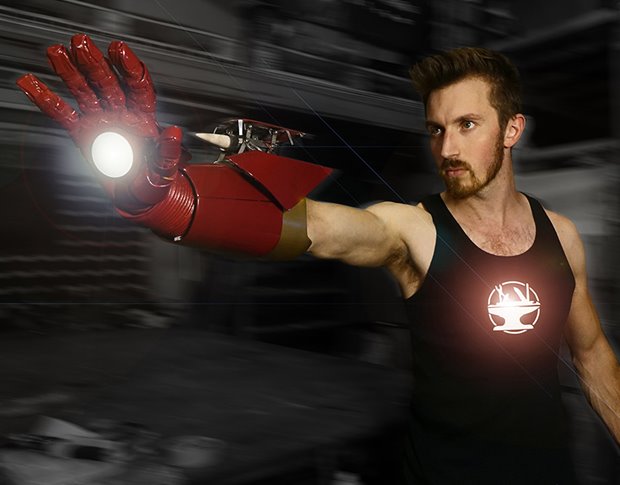
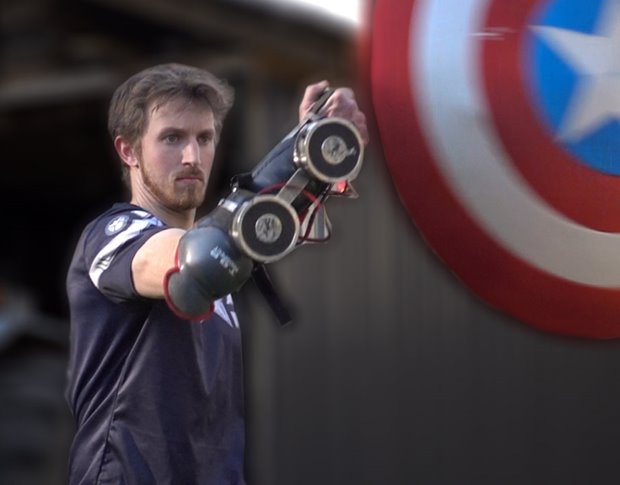
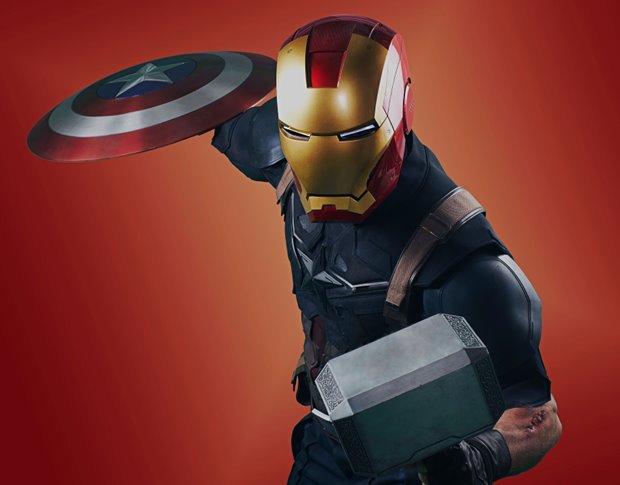
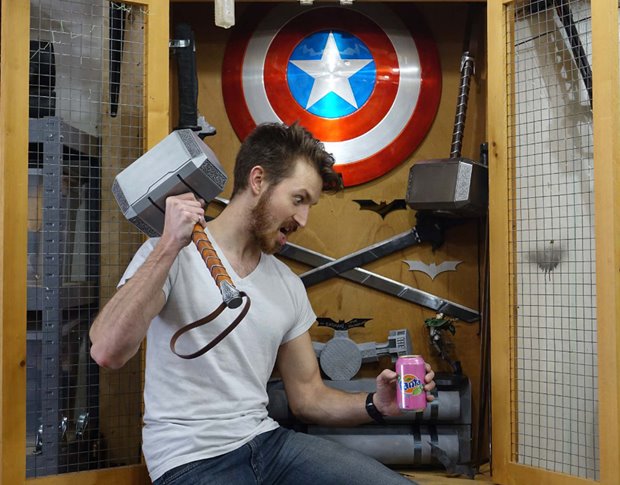
.png?width=854&height=480&ext=.png)



